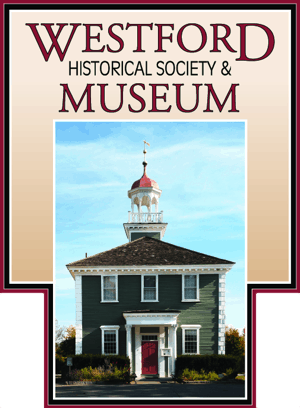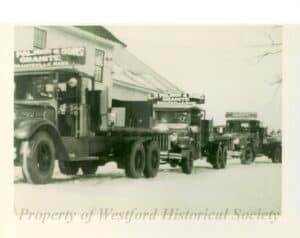Westford has a long history in industry, with the earliest recorded granite quarrying beginning in 1826 on Oak Hill, near today’s Fletcher Granite company. Granite from here is known for its clean blue-gray appearance, “Chelmsford Gray.” The earliest operations occurred before the use of railroads, with the old horse and carriage at one point. Into the twentieth century, the two main areas for quarrying were Snake Meadow Hill in Graniteville and Oak Hill in Nabnasset. Nearly half of the active quarries in town were on Snake Meadow Hill by 1911. Snake Meadow Hill operations slowly wound down by the late nineteenth century. The sole remaining quarry in town is off Oak Hill. It is owned by the Fletcher Granite Company, founded by H.E. Fletcher in 1881. Fletcher’s Chelmsford Gray is found in found in town and elsewhere in the country.
Palmer Granite
In today’s Graniteville, 1847, Benjamin Palmer quarried the north side of Snake Meadow hill. Operations continued into the twentieth century. The operation was purchased by Essex Bituminous Concrete Corp of Peabody in the 1940s. Overall operations wound down in the 1970s.
Photograph
Ca. 1930
W.2001.109
Fletcher Quarry
This photo of the Fletcher Quarry at Oak Hill was taken in 1949. According to the company’s website, Fletcher developed a joint cutting saw for making straight curb after quarrying in 1965, as well as later innovations such as a multi-diamond wire quarry saw for curbing slab directly in the quarry in 2004. While Fletcher Granite Co. was established in 1881, nearly half of the active quarries in town were on Snake Meadow Hill by 1911. Today, Fletcher’s Oak Hill quarry represents the only remaining Westford operation.
Photograph
2.5 x 4.5″
W.2001.106
The History of Graniteville, Massachusetts
Geoff Hall conducts a wonderful and in-depth look into the
history of one of Westford’s storied mill villages.
Where Has All The Granite Gone?
In 2003 the Westford Historical Society published a calendar titled “Where has all the Granite Gone?”
Researched and created by Marilyn Day, Westford Town Historian (2003), Slideshow edited by Alina Jeng, Westford Historical Society Intern (2020)
Timeline Set in Stone
19th Century
1826 – Quarrying began on the ledge on Oak Hill by Issac Carkin. After, Major Jesse Colburn and later George W. Merrill worked the ledge. Most of the stone was used for curbing and paving.
Ca. 1845 – Hildreth quarry is active on west side of Snake Meadow Hill. The stone was used for buildings and curbing.
1847 – In today’s Graniteville, Benjamin Palmer began quarrying on two sites on the north side of Snake Meadow Hill. Benjamin Parker quarried “cobbles” there as well, and stone from Parker’s site was used for a bridge over Stony Brook and general curbing.
1848 – Samuel Fletcher of Groton opened more of the ledge on Snake Meadow Hill. Much of this stone was used for the Merrimack River dam in Lawrence, MA.
1853 – William Reed of Acton bought 61 acres on Snake Meadow Hill. He initially ran the business with his brother, David, who later divided the lot. William worked the top portion of the hill, while David worked the area near Cowdry Hill. Asa Bond briefly quarried Cowdry Hill, before moving to Concord, NH. The Snake Meadow Hill Quarries supplied much of the granite for the state prison on Concord, MA, and existed into the 20th century.
1860 – H.N. Fletcher quarry opens on south side of Snake Meadow Hill. The stone was used for buildings and curbing.
1880 – Wright quarry opens of east side of Snake Meadow Hill. The stone was used for curbing.
1881 – Herbert Ellery “Hobbie” Fletcher (1862-1956) opened the quarry still operated today as “Fletcher Granite Co.” on the border to Chelmsford, near Oak Hill. The Chelmsford Gray continues to be used for buildings, bridges, curbing, and paving. This stone is found across the country in such places as Quincy Market in Boston, the Federal Building in Boston, and the columns of the Treasury Building in Washington, DC.
1899 – Peterson Quarry opens on Oak Hill near H.E. Fletcher. Stone was used for trimmings, steps, sills, and curbing.
20th Century
1905 – Perley Carkin Quarry opens on Oak Hill near H.E. Fletcher. The stone was used for curbing, paving, and trimmings.
1906 – Couture quarry opens on the west side of Snake Meadow Hill. The stone was used for curbing.
1908 – Town approved funds, up to $40, for a block of granite from Herbert V. Fletcher’s Quarry to be used by Provincetown for the Pilgrim Monument. This quarry closed in 1940 when there was no more granite.
1909 – Cartwright opens dormant quarry on Oak Hill near H.E. Fletcher. The stone was used for curbing.
1910 – Morris and Luke quarry opens on Oak Hill near old Carkin quarry. New Carkin quarry opens, also on Oak Hill. The stone from these sites were used for curbing and paving.
1911 – 13 active quarries in town, six located on Snake Meadow Hill.
1922 – George Morris began quarrying land on Forrest Rd near Flushing Pond. This land was later owned by Velmos H. Stone of N. Chelmsford by 1973.
1923 – Other active quarries on Oak Hill included Prescott Quarry (operated by Arthur Decarteret and Baker Lot Quarry (operated by Thomas LeMasurier).
1930 – Palmer and Sons Granite was the oldest family operated quarry in New England, 1940 – The quarry started by Samuel Fletcher closes.
1940s – Palmer Granite transfers operations to the Essex Bituminous Concrete Corp of Peabody, and at least in partial operation into the 1970s.
1955 – H.E. Fletcher Co. operations of a neighboring quarry then owned by Clarence DeCartaret.
1985 – Fletcher Granite Co. sells to Australian Pioneer International, Ltd.
21st Century
2010 – Fletcher Granite Co. briefly shuts down due to financial issues, and later sold.
2019 – Now the only active granite quarry in town, Fletcher Granite Co. quarries and sells 17 types of granite from across New England, including Westford’s Chelmsford Gray.



